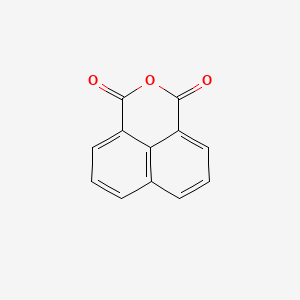D0609 | 1h,3h-naphtho(1,8-cd)pyran-1,3-dione
| Toxicity | Dose | Time | Species | Model | Method | Action | Positive criterion | Reference |
|---|---|---|---|---|---|---|---|---|
| MEMBRANE POTENTIAL | 3.89±1.12 | human | qHTS-HepG2 | MMP assay | decrease | IC50 | 163 | |
| MEMBRANE POTENTIAL | 7.94 | human | HepG2 | MMP assay | decrease | IC50 | 163 | |
| MEMBRANE POTENTIAL | rat | hepatocytes | MMP assay | Negative | IC50 | 163 | ||
| Pictogram | Signal | Statements | Precautionary Statement Codes |
|---|---|---|---|
 |
Warning |
Aggregated GHS information provided by 135 companies from 8 notifications to the ECHA C&L Inventory. Each notification may be associated with multiple companies. Reported as not meeting GHS hazard criteria by 6 of 135 companies. For more detailed information, please visit ECHA C&L website Of the 7 notification(s) provided by 129 of 135 companies with hazard statement code(s): H315 (34.88%): Causes skin irritation [Warning Skin corrosion/irritation] H317 (65.12%): May cause an allergic skin reaction [Warning Sensitization, Skin] H319 (99.22%): Causes serious eye irritation [Warning Serious eye damage/eye irritation] H335 (34.11%): May cause respiratory irritation [Warning Specific target organ toxicity, single exposure Respiratory tract irritation] Information may vary between notifications depending on impurities, additives, and other factors. The percentage value in parenthesis indicates the notified classification ratio from companies that provide hazard codes. Only hazard codes with percentage values above 10% are shown. |
P261, P264, P271, P272, P280, P302+P352, P304+P340, P305+P351+P338, P312, P321, P332+P313, P333+P313, P337+P313, P362, P363, P403+P233, P405, and P501; (The corresponding statement to each P-code can be found at the GHS Classification page.) |
| 1,8-Naphthalene dicarboxylic acid | 1,8-Naphthalenedicarboxylic acid anhydride | 1,8-Naphthalenedicarboxylic anhydride |
| 1,8-Naphthalic acid anhydride | 1,8-Naphthalic anhydride | 1,8-Naphthalic anhydride, 97% |
| 1,8-Naphthanoic anhydride | 1,8-Naphthoic anhydride | 1,8-naphthalene dicarboxylic anhydride |
| 1,8-naphthalicanhydride | 1H,3H-Benzo[de]isochromene-1,3-dione | 1H,3H-Benzo[de]isochromene-1,3-dione # |
| 1H,3H-Naphtho(1,8-cd)pyran-1,3-dione | 1H,3H-Naphtho(1,8-cd)pyran-1,3-dione (9CI) | 1H,3H-Naphtho[1,8-cd]pyran-1,3-dione |
| 1H,8-cd]pyran-1,3-dione | 3-oxatricyclo[7.3.1.0,(1)(3)]trideca-1(13),5,7,9,11-pentaene-2,4-dione | 3-oxatricyclo[7.3.1.0?,??]trideca-1(13),5,7,9,11-pentaene-2,4-dione |
| 3-oxatricyclo[7.3.1.0^{5,13}]trideca-1(13),5,7,9,11-pentaene-2,4-dione | 32RS852X55 | 34314-32-4 |
| 5-17-11-00492 (Beilstein Handbook Reference) | 81-84-5 | AB1003406 |
| AC-19760 | AI3-09071 | AK-968/40208880 |
| AKOS000119799 | ANW-58687 | BBL013053 |
| BDBM50146058 | BRN 0153190 | Benzo[de]isochromene-1,3-dione |
| C19125 | CAS-81-84-5 | CHEBI:82246 |
| CHEMBL316059 | CTK8B7815 | DB-056557 |
| DSSTox_CID_6505 | DSSTox_GSID_26505 | DSSTox_RID_78127 |
| DTXSID4026505 | EBD50019 | EC 201-380-2 |
| EINECS 201-380-2 | F0001-2093 | FT-0607054 |
| GRSMWKLPSNHDHA-UHFFFAOYSA-N | HSDB 7371 | InChI=1/C12H6O3/c13-11-8-5-1-3-7-4-2-6-9(10(7)8)12(14)15-11/h1-6; |
| KS-00000WS2 | KSC917Q1L | LS-95107 |
| MCULE-8718069449 | MFCD00006925 | N0022 |
| NCGC00248503-01 | NCGC00257599-01 | NE10462 |
| NSC 5747 | NSC-5747 | NSC5747 |
| Naphthalene-1,8-dicarboxylic acid anhydride | Naphthalene-1,8-dicarboxylic anhydride | Naphthalenedicarboxylic-1,8-anhydride |
| Naphthalic acid anhydride | Naphthalic anhydride | Naphthalic anhydride (7CI,8CI) |
| Naphtho[1,8,8a-c,d]pyran-1,3-dione | PS-4566 | Pakarli |
| Protect | Protect (agrochemical) | Q-200092 |
| Q424800 | RTR-031063 | SBB061435 |
| SC-23339 | SCHEMBL30415 | ST2419122 |
| ST45061720 | STK301830 | STR00696 |
| TR-031063 | Tox21_200045 | UNII-32RS852X55 |
| WLN: T666 1A M CVOVJ | ZINC8457049 |
| CAS Number | 34314-32-4, 38052-94-7, 81-84-5 |
| PubChem Compound | 6693 |

